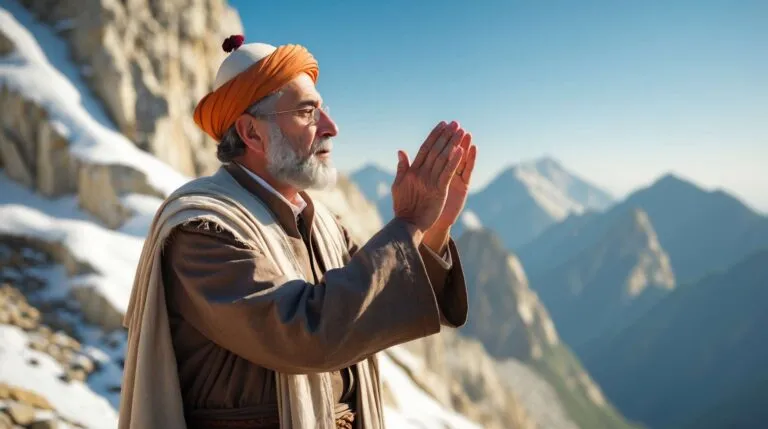Many Jews balk at the idea of praying at Kivrei Tzadikim. They argue that the Torah explicitly prohibits one to “inquire after the dead” and going to cemeteries and praying there is a violation of that Mitzvah.
However, praying at Kivrei Tzadikim is an ancient practice of normative Judaism. The most iconic example we have is when Calev prayed at the tomb of Avraham Avinu before setting out to explore the land with the Meraglim (spies). In Sha’ar HaGilgulim, Rav Chaim Vital teaches that Calev was the reincarnation of Eliezer, servant of Avraham, and he came to ask for the favor of having his former master intercede on his behalf for all the years he worked under him.
The Kitvei Ari also contains references of Yichudim, Kavanot, and advice on how and when to go to Kivrei Tzadikim. Clearly, the Ari and Rabbi Chaim Vital (and also Calev) were not concerned over violating the Mitzvah of “inquiring after the dead. Many other Sephardi Kabbalists and Chassidic Masters followed along the path of the Arizal and prayed extensively at the tomb of Tzadikim.
So, how do we conciliate these two positions? And what is it in the cemetery?
In this article, we will see how to answer this question and explain how going to Kivrei Tzadikim work in detail.
Answering the question
Let’s take our question out of the way already:
The Zohar already answered the big question on how to conciliate the question on the Mitzvah of not “inquiring after the dead. We know from the Talmud that cemeteries are places filled with Tumah. Coming in contact with a dead body (or passing over it), cause one to become an “Av HaTumah” (father of Tumah).
It’s important to understand that Tumah, often translated as “impurity”, is not some “spiritual goo”. Rather, it’s a type of malaise that cause fragmentation of the soul, blocking it from seeing the light of Hashem. This is why people were required to undergo the purification of the water of the Red Heifer to enter the Holy Temple. Nowadays we only have the Mikvah, and that still effects a great deal of purification.
The Zohar teaches that it’s not the souls of the Tzadikim that are impure (chas v’shalom). Rather, it’s the demonic entities and unclean spirits, the Sitrah Achra in general, that surround the Kever that are the problem. The Arizal warned Rav Chaim Vital against going to the burial grounds of wicked people lest one would attach to his soul who was on a very high level.
In summary: Going to Kivrei Tzadikim is then a very good practice, while going to Kivrei Reshaim violates the Mitzvah of “Lildrosh Al HaMetim”.
3 levels of the soul
The Zohar teaches in many places that the 3 lower levels of the soul, Nefesh, Ruach and Neshama vest themselves inside a person. These are the 3 levels need rectification even though almost everything is about the Nefesh which is the lowest of them all. The Ruach and Neshama barely need any work because they rarely sin, if at all.
When a person dies, his Nefesh stays in the grave. The Ruach goes to Gan Eden (presumably in the spiritual world of Yetzirah), and the Neshama stays under the Kisse HaKavod (Hashem’s Throne of Glory, presumably in the spiritual world of Beriyah).
The Zohar also speaks about the Havla D’Garmei that inhabit the Kivrei Tzadikim. This is literally called the “breath of the bones” which is a faint light (of nitzotz, spark) that keeps the bones from rotting completely so they can be revived in the future.
Because the Tzadik buried there purified himself to an extreme and served Hashem wholeheartedly, Kivrei Tzadikim form a passageway that enable prayers to arise straight to the Kisse HaKavod. It seems like the reason is that the Nefesh, Ruach and Neshama of the Tzadik connect all the way there. Since righteous people only seek to help, he can elevate the prayer to the Throne of Glory without problems.
Conditions to go to Kivrei Tzadikim
First things first: go to the Mikvah. This cannot be stressed enough.
We mentioned in the beginning of this article that the cemetery is filled with Tumah, so don’t make it easy for them to attach themselves to you. One must also do Teshuva in his heart and resolve to follow the Torah. Doing this takes care of almost every problem that can arise from going there.
Another important point for men is: do not look at women there, preferably keep your eyes down. Because we are going to a place where we are bound to be “weaker” spiritually, looking at women around can invoke serious accusations in Shamayim. Sure, nothing happens when one is there, as most people don’t feel anything bad. But problems can arise in weeks, months or years, and they don’t realize this suffering came as a result of looking at women in the cemetery.
Rav Chaim Vital teaches in Sha’ar Hagilgulim that the best days to go Kivrei Tzadikim is on the Hilula/Yortzait of the Tzadik. Besides that, one should strive to go on the 15th and 29th of the Jewish month. This is because the Nefesh buried there receives a “special illumination” which increases its power.
Never go there at night as this is a time of dinim, and preferably not alone as well. This should be obvious.
Before entering the cemetery, accept upon yourself the 4 Mitot Beit Din to purify oneself from bad thoughts/desires:
According to the Tzeitl Katan by Rabbi Elimelech M’Lizhensk, this Kavanah is also good to be used anytime a person finds himself “without anything better to do”. Imagine yourself receiving the 4 punishments and you will do a great detail of Tikkun on the soul.
Other good advice involve going to the Mikvah when you leave the cemetery. This will eliminate most of the Tumah that attached itself to one’s soul during the visit and serve as extra protection.
Praying in a cemetery – How it works
As we saw before the Nefesh, Ruach and Neshama of the Tzadik form a passageway for the Tefilot all the way to the Throne of Glory.
R’ Mordechai Sharabi wrote a very interesting book called Tefila L’Moshe. The word L’Moshe (למשה) is an acronym for L’Rabbenu Mordechai Sharabi HaTzadik (I recommend it). In it, he brings many Tefilot, but also a sort of greeting one can do to the Tzadik buried there. There are also certain petitions one prays to Hashem to benefit the Tzadik there.
I realize this might sound strange to most people, but this is how it works: you benefit the Tzadik, and the Tzadik benefits you. You ask Hashem to elevate him, the Tzadik will elevate your prayer to Hashem.
The Tzadik buried there is not some robot that stays there and acquiesces to all our wishes. He’s a sentient soul, not our servant, that wishes to help us to the best of his abilities but won’t take insults lightly. It’s perfectly fine to ask for help in elevating one’s prayer like Calev asked Avraham for help to intercede on his behalf. One can also ask questions for him about which path to take, what to do and so on.
Of course, all power comes from Hashem. Ultimately it’s Hashem who will judge whether the Tefila is worthy or not of being fulfilled. It’s also Hashem who gives power to the Tzadikim. But Hashem also loves Tzadikim even after their death, and accepts the prayers more readily when a Tzadik is bringing it to Him. One must never forget this.
If one know the Yichud from Sha’ar Ruach HaKodesh for uniting yourself with the Tzadik you can do it (check conditions for Yichudim here). This Yichud enables one to unite his Chaya with the Chaya of the Tzadik, his Neshama to his Neshama, the Ruach with the Ruach and the Nefesh with the Nefesh in order to unite the spiritual worlds:
This Yichud can be very powerful and, if a person is sufficiently strong mentally, can also bring the revelation of the Tzadik, like Rav Chaim Vital writes extensively in his autobiography, Sefer HaChezionot (book of visions). Again, there’s nothing wrong with asking Tzadikim questions, if one happens to reveal himself to you.
While it used to be a custom to lie down completely on Kivrei Tzadikim to effectively unite with the Tzadik, this custom has been abolished and people only put their hands on the tomb.
Lying down completely on Kivrei Tzadikim may be very dangerous as it may invite the Sitra Achra to attach itself to the person to a severe degree. Please take this seriously.
Final considerations
I believe this article should dispel most of the doubts people have about going to Kivrei Tzadikim. I hope also that this helps people understand the importance of this ancient Jewish practice and lose fear of going there.
If you take care and follow the advice here, you only stand to gain, with virtually zero risk.
Done properly, going to Kivrei Tzadikim is an extremely beneficial practice. One can jump many levels in Avodat Hashem with relatively small efforts. One can receive a message from the Tzadik buried there, or even an yibur (pregnancy) of his soul that will help him rise even further.
One of the Lamed Vavnikim (36 hidden Tzadikim) called R’ Yosef Shlomo Dayan Zt”l wrote once that praying one hour in a Kever Tzadik is equal to 100 hours of study in the Beit Midrash. Think about that.
Sometimes a person doesn’t feel any difference for performing a Mitzvah, Limud Torah or Tefila. This is because the Tikkun is done on the deeper levels of the soul, and it’s fine. While I’m a big proponent of training oneself to “experiencing things”, I realize not everything works like that. Part of the work is often going with Mesirut Nefesh to perform what we are meant to perform.
So, if you ever want to go to Kivrei Tzadikim, prepare yourself accordingly, do Teshuva (for real), give some Tzedaka, pray for Hashem to protect you, go to the Mikvah if you are a man, keep your eyes focused on the ground, and b’hatzlacha!







